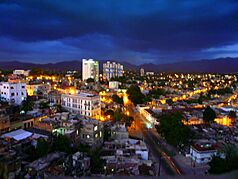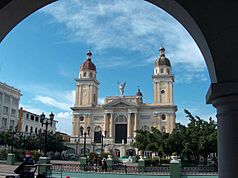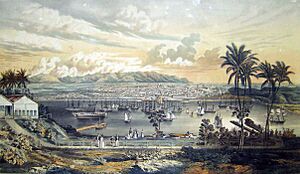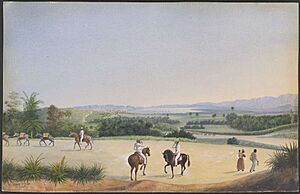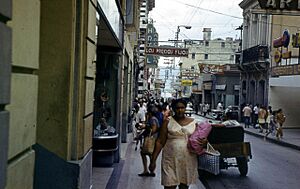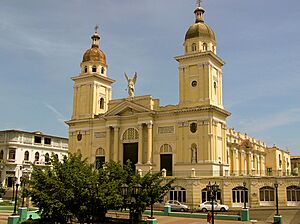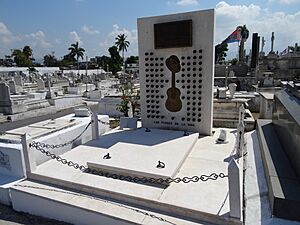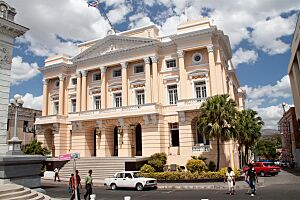Santiago de Cuba facts for kids
Quick facts for kids
Santiago de Cuba
Santiago de Cuba
|
|||
|---|---|---|---|
|
From top down: Aerial view of the city during nighttime, the Metropolitan Cathedral of Santiago de Cuba, the city welcome sign with the city's motto.
|
|||
|
|||
| Motto(s):
Rebelde ayer, hospitalaria hoy, heroica siempre (Spanish) ("Rebellious yesterday, hospitable today, always heroic") |
|||
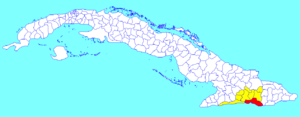
Santiago municipality (red) within
Santiago Province (yellow) and Cuba |
|||
| Country | Cuba | ||
| Province | Santiago de Cuba | ||
| Established | 1515 | ||
| Founded by | Diego Velázquez de Cuéllar | ||
| Area | |||
| • Municipality | 1,023.8 km2 (395.3 sq mi) | ||
| Elevation | 82 m (269 ft) | ||
| Population
(2022)
|
|||
| • Municipality | 507,167 | ||
| • Urban | 451,528 | ||
| • Rural | 55,639 | ||
| Demonym(s) | santiaguero/a | ||
| GDP (PPP, constant 2015 values) | |||
| • Year | 2023 | ||
| • Total | $6.2 billion | ||
| • Per capita | $14,000 | ||
| Area code(s) | +53 22 | ||
Santiago de Cuba is the second-largest city in Cuba. It is also the capital city of the Santiago de Cuba Province. You can find it in the southeastern part of the island. It's about 870 kilometers (540 miles) southeast of Havana, Cuba's capital.
The city is located on a bay that connects to the Caribbean Sea. This makes it a very important sea port. In 2022, Santiago de Cuba had a population of 507,167 people. The area around the city, called the municipality, covers about 1023.8 square kilometers (395.3 square miles). It includes smaller communities like Antonio Maceo, Daiquirí, and Siboney.
Contents
A Look Back in Time
Santiago de Cuba was the seventh village founded by the Spanish conquistador Diego Velázquez de Cuéllar. This happened on July 25, 1515. A fire destroyed the settlement in 1516, but it was quickly rebuilt.
This city was a starting point for many important trips. Explorers like Juan de Grijalba and Hernán Cortés left from here in 1518 to explore the coasts of Mexico. Later, in 1538, Hernando de Soto began his journey to Florida from Santiago. The first cathedral in the city was built in 1528. Santiago was the capital of the Spanish colony of Cuba from 1522 until 1589.
Over the years, different forces attacked the city. French forces looted it in 1553. English forces raided it in 1603 and again in 1662.
New People Arrive
In the late 1700s and early 1800s, many French and British people moved to Santiago. Around 18,000 refugees came from Saint-Domingue (now Haiti) in 1803. They were fleeing the Haitian Revolution, a major slave revolt that began in 1791. These refugees included French white people, free people of color, and African freedmen.
These new arrivals added to the city's already rich mix of Spanish and African cultures. In 1809, after Napoleon Bonaparte's forces invaded Spain, French citizens were told to leave Cuba. Many went to the United States, especially to New Orleans.
The Spanish-American War
Near the end of the 1800s, during the Spanish–American War, Santiago was a key battleground. Spanish troops faced a major defeat at San Juan Hill on July 1, 1898. After capturing the hills nearby, United States General William Rufus Shafter surrounded the city. Spain later surrendered to the United States after Admiral William T. Sampson destroyed the Spanish fleet outside Santiago's harbor on July 3, 1898.
Cuba declared its independence from Spain. However, US troops stayed in Cuba for several years. This was to make sure the sugar farms kept working. José Martí, a famous Cuban poet and national hero, is buried in Santa Ifigenia Cemetery in Santiago.
Santiago's Role in the Cuban Revolution
Santiago was home to Frank País, a hero of the 20th-century Cuban Revolution. On July 26, 1953, the revolution began with an attack on the Moncada Barracks. This attack was led by Fidel Castro and a small group of rebels.
After this event, Frank País started talking with students and young workers. He built a strong group that helped the revolution in the cities. His group gathered weapons, money, and medical supplies. They also printed a newsletter to share news that the government tried to hide.
In 1955, País's group joined Castro's 26 July Movement. País became a leader in the Oriente province. Sadly, two years later, he was captured and killed.
On January 1, 1959, Fidel Castro announced the victory of the Cuban Revolution. He made this announcement from a balcony at Santiago de Cuba's city hall. Frank País's ashes were buried in Santa Ifigenia Cemetery, next to José Martí.
Culture and Traditions

Santiago de Cuba is known for its lively culture. Many famous Cuban musicians were born here or nearby. These include Compay Segundo, Ibrahim Ferrer, and Eliades Ochoa. They all appeared in the film Buena Vista Social Club.
The city is famous for its traditional music, especially son. This type of music is where salsa dancing comes from. Santiago also celebrates Carnival in July. During Carnival, traditional conga music is played in the streets using a special trumpet called the trompeta china.
Many people in Santiago de Cuba follow Afro-Cuban religions, like santería. The city also has a community of people whose families came from Haiti in the early 1800s. Some of the religious traditions of "vodún" in the city come from this community.
The city's buildings show many different styles, from Baroque to neoclassical. Many old colonial buildings have large windows and balconies. From these, people can see the steep streets and green hills. Important historical sites include the first Spanish home in the Americas and the first cathedral in Cuba. Also, the Cobre mine, the first copper mine in the Americas, is nearby.
World Heritage Sites
The local fortress, San Pedro de la Roca, is a UNESCO World Heritage List site. It is considered a great example of Spanish-American military architecture.
The Baconao Park was also added to the UNESCO World Heritage Biosphere Reserve List in 1987.
Geography and Climate
Santiago de Cuba is in the southeast of Cuba. It sits at the foot of a bay and is surrounded by the Sierra Maestra mountains. The city has a hot and humid climate. The landscape mixes city buildings with natural green areas and ocean views. The city's design, with its steep streets, is shaped by the bay and hills.
Under the Köppen climate classification, Santiago de Cuba has a tropical savanna climate. This means it has warm temperatures all year round.
| Climate data for Santiago de Cuba | |||||||||||||
|---|---|---|---|---|---|---|---|---|---|---|---|---|---|
| Month | Jan | Feb | Mar | Apr | May | Jun | Jul | Aug | Sep | Oct | Nov | Dec | Year |
| Mean daily maximum °C (°F) | 28 (82) |
28 (82) |
28 (82) |
28 (82) |
28 (82) |
29 (84) |
31 (88) |
31 (88) |
31 (88) |
30 (86) |
30 (86) |
30 (86) |
29 (85) |
| Mean daily minimum °C (°F) | 21 (70) |
21 (70) |
22 (72) |
23 (73) |
23 (73) |
24 (75) |
25 (77) |
25 (77) |
24 (75) |
24 (75) |
23 (73) |
22 (72) |
23 (74) |
| Average precipitation mm (inches) | 73.7 (2.90) |
43.2 (1.70) |
53.3 (2.10) |
58.4 (2.30) |
139.7 (5.50) |
101.6 (4.00) |
68.6 (2.70) |
94 (3.7) |
106.7 (4.20) |
193 (7.6) |
94 (3.7) |
81.3 (3.20) |
1,107.5 (43.6) |
| Source: weather.com | |||||||||||||
Population Information
In the 2012 population count, Santiago de Cuba had 431,272 people. By 2022, the population grew to 507,167.
| 1861 | 1899 | 1907 | 1919 | 1931 | 1943 | 1953 | ||||
|---|---|---|---|---|---|---|---|---|---|---|
| 36,752 | 43,090 | 45,470 | 62,083 | 101,508 | 118,266 | 163,237 | ||||
| 1970 | 1981 | 2002 | 2012 | 2021 | 2022 | |||||
| 277,600 | 347,279 | 423,392 | 431,272 | 508,105 | 507,167 | |||||
| All figures are census figures. | ||||||||||
Getting Around Santiago
Santiago is served by the Antonio Maceo Airport. You can fly from here to Havana and other cities in the Caribbean.
For public transport, the city has two main systems. Omnibus Metropolitanos (OM) connects the city center with nearby towns. Metrobus serves the inner-city area.
Ferrocarriles de Cuba railways and ASTRO inter-city buses connect Santiago with Havana and most other major cities in Cuba. The main railway station, "General Senén Casas", was rebuilt in 1997. The city is also crossed by the Carretera Central highway.
Education
The main university in Santiago de Cuba is the University of Santiago de Cuba (Universidad de Oriente – Santiago de Cuba, UO).
Famous People from Santiago
Many well-known people were born or lived in Santiago de Cuba:
- Yordenis Ugás – a boxer.
- Desi Arnaz – an actor, producer, and bandleader.
- Emilio Bacardí – a business leader and giver to charity.
- Ibrahim Ferrer – a musician.
- José María Heredia y Heredia – a poet.
- Alberto Juantorena – an Olympic gold medalist in 1976.
- Antonio Maceo Grajales – a hero of Cuba's independence.
- Rita Marley – a singer and wife of Bob Marley.
- José Martí – an independence hero, buried here.
- Eliades Ochoa – a musician.
- Frank Pais – a revolutionary leader.
- Ñico Saquito – a musician and composer.
- Compay Segundo – a musician.
International Connections
Santiago de Cuba has "twin city" relationships with other cities around the world:
 Diadema, São Paulo, Brazil
Diadema, São Paulo, Brazil Naples, Italy
Naples, Italy Oakland, California, United States
Oakland, California, United States Rosario, Argentina
Rosario, Argentina
Images for kids
-
Desi Arnaz
Actor
(1917–1986) -
Compay Segundo
singer
(1907–2003)
See also
 In Spanish: Santiago de Cuba para niños
In Spanish: Santiago de Cuba para niños


